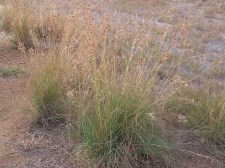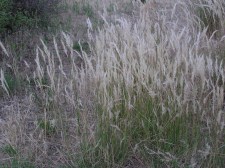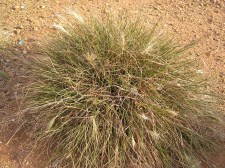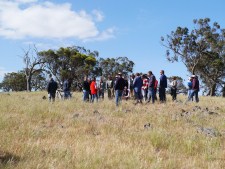In South Australia, remnant native grasslands are found on non-arable country, either in the ranges or on soils that are not suited to cultivation. These grasslands form the basis of grazing systems in these areas and are usually referred to as native pastures.
The ranges are vulnerable to fire, and large areas of native pastures were burnt in the Bangor and Eden Valley fires early in 2014. While fire is a catastrophic event for the landholder, it is also a catastrophic event for a pasture, although a pasture based on native grasses has evolved to cope with fire better than a pasture based on introduced plants. A catastrophic event, such as fire, is followed by a process which is known to ecologists as “succession”.
The first step to recovery in a burnt native pasture is the colonization of the bare ground by species that thrive in extreme conditions. As all the ground cover and litter has been burnt, broadleaved weeds (such as Salvation Jane, Crowsfoot, and cape weed), and annual grasses( such as ryegrass, silver grass, wild oats and barley grass) will dominate the new plant growth. These weeds are called “colonizing” species – species that grow best with little competition from other plants; are adapted to grow in lots of sunlight;and that thrive in soils that are dry, exposed and relatively low in nutrients.
In amongst these colonizing species, there will be native grasses. As the native grasses are nearly all perennial plants in the agricultural districts of South Australia, after all but the hottest burns they are able to re-grow from their underground roots. Many landholders noticed in 2014, after the rains that fell following the fires, that there were small green tussock or bunch grasses appearing in their paddocks. These green tussocks are the native grasses, and they are able to draw on energy stored underground in their roots to regrow their leaves. As these plants grow their new leaves, they produce energy through photosynthesis. Depending on temperature and moisture conditions, they will need up to 90 days of growth before they have replenished the energy stores in their roots. It is critically important for the long term production and survival of these perennial plants that they have time to replenish their root stores before being grazed, so keeping animals off recovering pastures after a fire is essential.
It is easy for a landholder to focus on all the annual weeds that seem to be taking over his pastures, but there is nothing to be gained by spraying these plants. What is happening is a natural process, and as the perennial grasses re-establish, and dead grasses and weeds form a litter cover on the surface of the soil, the weedy annual colonizing plants will gradually reduce in number over subsequent years as there is more competition among the plant for water, light and nutrients. The perennial plants grow best when there is more competition for resources, and when the ground has more surface cover, or litter. The best way to assist this process is to maintain ground cover in the pasture by keeping the paddocks destocked in the first few months following the fire, and by not overstocking the pasture when it is grazed again.
The conditions that followed the fires in 2014 also were ideal for the recruitment of native grasses into the burnt pastures. A good rainfall event in late summer or early autumn provides the warm, damp conditions that are ideal for the germination of any native grass seed in the soil seed bank. The seedling native grasses are tiny and difficult to tell apart from annual grass seedlings, but if the grazing is withheld for several months after the rainfall event, these seedling native plants will form small tussocks and be well enough established to survive a light graze. As with all newly established pastures, native pastures need to be grazed lightly for the first growing season, and in subsequent seasons they should be well enough established to be part of the normal farm programme.
The dominant grasses in native pastures in the agricultural districts in South Australia are Wallaby Grass (Austrodanthonia Spp), and Spear Grasses (Austrostipa spp), which are both winter growing, and Brush Wire Grass ( Aristida behriana) and Kangaroo Grass (Themeda australis).

Landholders should be able to identify these grasses and there are fact sheets produce local by the Native Grass Resources Group in the Adelaide Hills (www.nativegrassgroup.asn.au), and the Mid North Grassland Working Group in the Mid North (www.nativegrass.org.au).

There are other native grass species, such as Native Wheat Grass (Elymus scaber ) and Weeping Grass (Microleana stipoides) which are also useful species but are less common in these regions. NRM Officers should also be able to help identify the common native grasses.

The most important thing to recognise is that all these native grasses are perennial plants – they can live and be productive for many years if properly managed. The key to managing them is to rotationally graze the pastures, to give the perennial plants time to rebuild their reserves before they are grazed again. Ideally the land manager will have enough paddocks to give each paddock a minimum rest of at least six weeks between grazing events.
In a really good native pasture, there is a range of small native broadleafed plants, which are usually referred to as “herbs and forbs”. There can be over 100 different small broadleaved native species, although many have disappeared due to overgrazing and it’s rare to see more than twenty or thirty of these small plants. Small, introduced clovers and medics, so widespread that they are said to be “naturalised”, have taken the place of these native species, and contribute to both the diversity of the native pastures, and to the soil nitrogen.
Once the land manager has learnt to recognise their key native perennial species, they need to monitor the growth of those plants. Animals are selective grazers, and will return to graze on the same plants again and again. In native pastures these plants are usually the most palatable perennial grasses, and they are also the plants that the landholder want to have in the pasture. When checking the stock, also look at a selection of the native grass tussocks. If they are being eaten down to ground level, they need time to recover, and the stock should be moved out of that paddock or the plants will not have enough energy to recover and will die. Stock should not be returned to that pasture until the monitored species has recovered – in spring, this may be 30 days, but in winter it can take up to 90 days.
Successful management of native pastures will result in a healthy, resilient and productive pastures that will perform well for many years.
